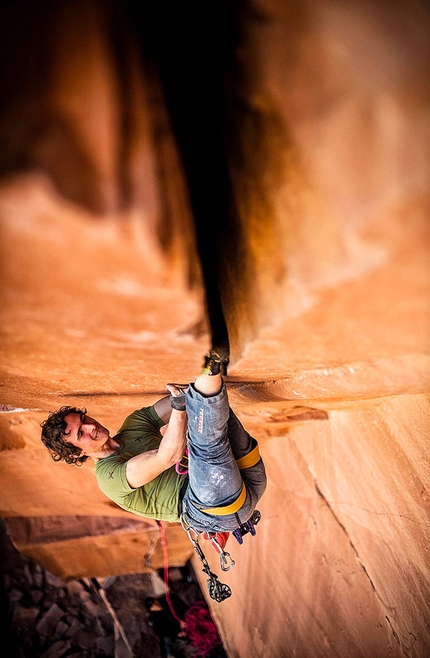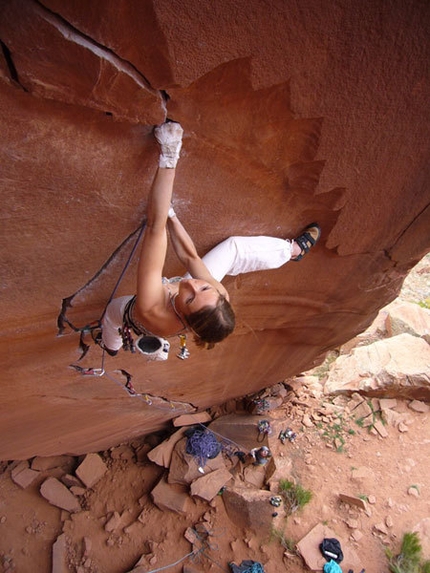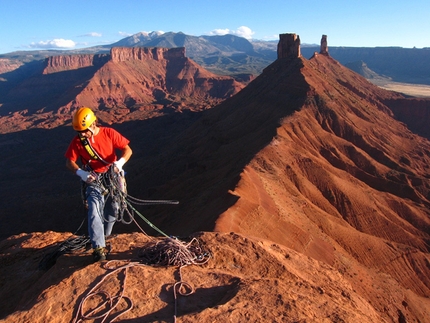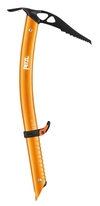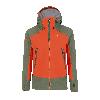Mari Salvesen flashes Belly Full of Bad Berries, notorious offwidth at Indian Creek, USA

 1 / 4
1 / 4 Mary Eden / @tradprincess
Mary Eden / @tradprincess
Belly Full of Bad Berries at Indian Creek, Utah, is widely recognised as one of the most famous offwidth cracks in the world. First ascended by Brad Jackson, the huge arch was famously attempted by Adam Ondra during his 2018 America road trip, who after climbing the line on his second go described it as "one the biggest fights of my life.”
In 2011 the crack climb was flashed by Britain’s Pete Whittaker and it has now been flashed for a second time, by Mari Salvesen from Norway. The ascent has been described, quite rightly, as "a massively significant ascent in offwidth climbing, crack climbing and women's trad climbing.” Here’s her in-depth report about the route in particular and offwidth climbing in general.
BELLY FULL OF BAD BERRIES FLASH by Mari Salvesen
Belly Full of Bad Berries is probably the most well-known offwidth in the world, for several reasons. It's very aesthetic, easy to take great photos on, easily accessible and of course insanely splitter. And it's hard, but not too hard, so that it’s still something that is fun for people to have a go at. Like most other trad climbers, I have known about this route for a long time, but I never had a specific plan to go try it until a few months ago, when an opportunity to travel to The States presented itself. It was an obvious route to put on the list, as I have been dabbling on the occasional offwidth for a few years now, and really enjoy them whenever I get the chance to climb one.
My first memory of an offwidth is probably when a friend of mine took me to Right Eliminate (E3 5c) at Curbar in the Peak District in 2017. It required a patient belay, but I figured out the body positioning as I went along, did a handstack, shuffled a knee and kicked with my outside leg and eventually got the onsight. It required a lot of work for each meter of movement. It was different and fun, and I wanted to do more of it. So since then I wouldn't say I have necessarily been seeking them out, but I have definitely not avoided them, like many climbers seem to do.
There are some very practical reasons to climb offwidths, too. Because where I live, it is something that people avoid, and so I find that there are quite a few first ascents still left to do in this style, even at established crags. I also come from a very wet country, so we work our climbing around that. Holding a wet crimp is awful, you'll fire off without warning. Holding a wet handjam is somewhat better. Staying in a wet offwidth is actually pretty decent. There is so much surface contact, that you can keep fighting, even in mossy and moist cracks. So that’s what I’ve been doing of late, and it turned out to be pretty good exercise for Indian Creek cracks, that are dry, splitter and, at worst, just a bit sandy.
The thing that I think makes offwidth climbing special is that it's so easy but at the same time really hard work. You can basically not fall off unless you give up, because there is always some bit of your body stuck between the rock, and you can always manage to keep the tension for just a little bit longer. Most of the time if you fall off an offwidth it is because you fail to move forward and give up. Last but not least, offwidths are safe, as you can place gear all the way. On vertical ones you can basically climb on a toprope the whole way, by bumping cams in front of you. So I find offwidths to be a nice mental break, as, aside from from trying really hard, it usually requires less mental commitment to run it out above gear.
Regarding the flash of Belly Full, I think this climb is a very flashable if you have the fitness for it. It’s splitter all the way, no surprises, you can plan from the ground what you need to do, and for most of the route you do the same move over and over again.When we started planning this trip, the devil on my shoulder, right from the beginning, kept nagging me that I should flash this route. It was annoying, because the realistic part of me thought it would be too hard. It looked so flashable, but the hype scared me a bit. I knew good crack climbers had worked on it without success, so I felt like a douche thinking I could just rock up from hibernation in Norway and do it. The day we went to try the route I was relaxed and happy to finally see it for myself, because at that point you can only do your best. From the film of Honnold and Ondra on it, I recognised the pod where they went from fists to inverted. When my fists didn't fit anymore, there was still a little way to that pod. So there was a moment of doubt when I realised how far I would have to climb inverted compared to them. But it turned out to be fine. And at the top I received some reassuring beta from Tom on the belay and Pete dangling at the anchor.
To prepare for this trip I tried to generally increase my fitness. My ability to pull bouldery moves is usually at a steady level, but when it comes to long days and multiple days of climbing I sometimes burn out. So I ate more, lifted weights, did my lock offs, some climbing on the autobelay, and a few sessions on the crack beams I have in my parent’s garage. I built a very short 45° offwidth in there, too. It ruined my shoes very quickly, and was completely the wrong size compared to Belly Full, so I don't think I had more than 3-4 sessions, but it was still surprisingly useful. On the part of the route where I went inverted, there are a few tricky moves before the feet fit into the crack, and I felt like I recognised the moves from my wooden beam back in Norway.
So what does this mean to me? The fact that people are so excited about my flash has been really fun. Crack climbers are such a jolly, supportive group of people, just plain psyched about everything! For me it was just good fun. And I find it very funny that me and the man I brush my teeth and plan dinner with every day, Pete Whittaker, are the only ones to have flashed this route, albeit more than 10 years apart.
However, I don't feel satisfied with my sends for very long, so instead of dwelling on it I immediately thought I want to climb something else. But it has given me confidence and confirmation that I could try even harder things while I’m here, even though I have sometimes struggled on "warm-ups". If I’m not motivated for a particular route, I struggle, regardless of the grade. So I might as well keep to routes that motivate me, which are usually the harder ones ;-)



 Copia link
Copia link

